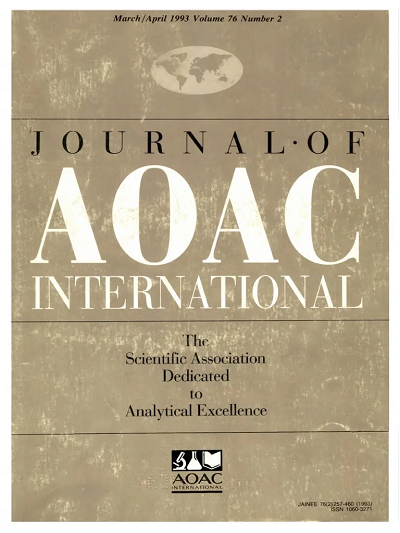Screening of 152 Veterinary Drug Residues in Animal Source Foods by LC-MS/MS, Multilaboratory Validation Study: Final Action 2020.04
IF 1.7
4区 农林科学
Q3 CHEMISTRY, ANALYTICAL
引用次数: 0
Abstract
Background The presence of veterinary drug residues in food-producing animals and animal products is regulated through the enforcement of maximum residue limits (MRLs). To answer the need of the food sector to monitor these substances in a wide range of food commodities, stakeholders at AOAC identified the need for a reliable confirmatory screening method. Such qualitative approach is required for compliance checking and to support product release in manufacturing. Objective Data were collected from 5 independent laboratories that applied the AOAC Official First Action Method AOAC 2020.04 to demonstrate adequate performance under reproducibility conditions. Probability of Detection (POD) was calculated in blank test samples and test samples spiked at the Screening Target Concentration (STC) level, with the objective to achieve PODs ≤ 10% and ≥ 90%, respectively. Additionally, the effectiveness of the screening method was assessed through participation to 92 proficiency test samples. Methods Four streams were optimized to screen for 152 veterinary drug residues by LC-MS/MS in a wide variety of food commodities including milk-based ingredients and related products (e.g., milk fractions, infant formula, infant cereals and baby foods), meat- and fish-based ingredients and related products (fresh, powdered, cooked, infant cereals and baby foods) and other ingredients such as eggs, animal fat and animal byproducts. The four streams covered 105 antibiotic residues, anti-inflammatory and antiparasitic agents (Stream A); 23 Beta-lactams (Stream B); 14 Aminoglycosides (Stream C) and 10 Tetracyclines (Stream D). Results The multi-laboratory validation led to PODs at the STC ≥ 94% and PODs in the blank ≤ 9%. Further application of the multi-laboratory validated method to 92 proficiency tests provided more than 99% satisfactory submitted results (n = 784). Conclusion The inter-laboratory reproducibility determined for this method met the acceptance criteria defined in AOAC SMPR 2018.010. Highlights AOAC has approved the method for Final Action Status.通过 LC-MS/MS 筛选动物源食品中的 152 种兽药残留,多实验室验证研究:最后行动 2020.04
背景 通过实施最高残留限量(MRL),对食用动物和动物产品中兽药残留进行监管。为了满足食品行业监测各种食品中这些物质的需要,AOAC 的利益相关者认为需要一种可靠的确证筛选方法。这种定性方法需要用于合规性检查和支持生产过程中的产品放行。目标 从 5 个独立实验室收集数据,这些实验室采用了 AOAC 官方首次行动方法 AOAC 2020.04,以证明在可重复性条件下具有足够的性能。计算了空白测试样品和在筛选目标浓度 (STC) 水平上添加的测试样品的检测概率 (POD),目标是分别达到 POD ≤ 10% 和 ≥ 90%。此外,还通过参与 92 个能力测试样本来评估筛选方法的有效性。方法 通过 LC-MS/MS 对四种方法进行了优化,以筛查多种食品中的 152 种兽药残留,这些食品包括奶类配料和相关产品(如奶粉、婴儿配方奶粉、婴儿谷物食品和婴儿食品)、肉类和鱼类配料和相关产品(新鲜、粉状、熟食、婴儿谷物食品和婴儿食品)以及蛋类、动物脂肪和动物副产品等其他配料。这四种成分流包括 105 种抗生素残留、消炎药和抗寄生虫药(成分流 A);23 种β-内酰胺类(成分流 B);14 种氨基糖苷类(成分流 C)和 10 种四环素类(成分流 D)。结果 通过多实验室验证,STC 的 POD ≥ 94%,空白处的 POD ≤ 9%。在 92 次能力验证中进一步应用多实验室验证方法,提交的结果满意度超过 99%(n = 784)。结论 该方法确定的实验室间重现性符合 AOAC SMPR 2018.010 中定义的验收标准。亮点 AOAC 已批准该方法为最终行动状态。
本文章由计算机程序翻译,如有差异,请以英文原文为准。
求助全文
约1分钟内获得全文
求助全文
来源期刊

Journal of AOAC International
医学-分析化学
CiteScore
3.10
自引率
12.50%
发文量
144
审稿时长
2.7 months
期刊介绍:
The Journal of AOAC INTERNATIONAL publishes the latest in basic and applied research in analytical sciences related to foods, drugs, agriculture, the environment, and more. The Journal is the method researchers'' forum for exchanging information and keeping informed of new technology and techniques pertinent to regulatory agencies and regulated industries.
 求助内容:
求助内容: 应助结果提醒方式:
应助结果提醒方式:


